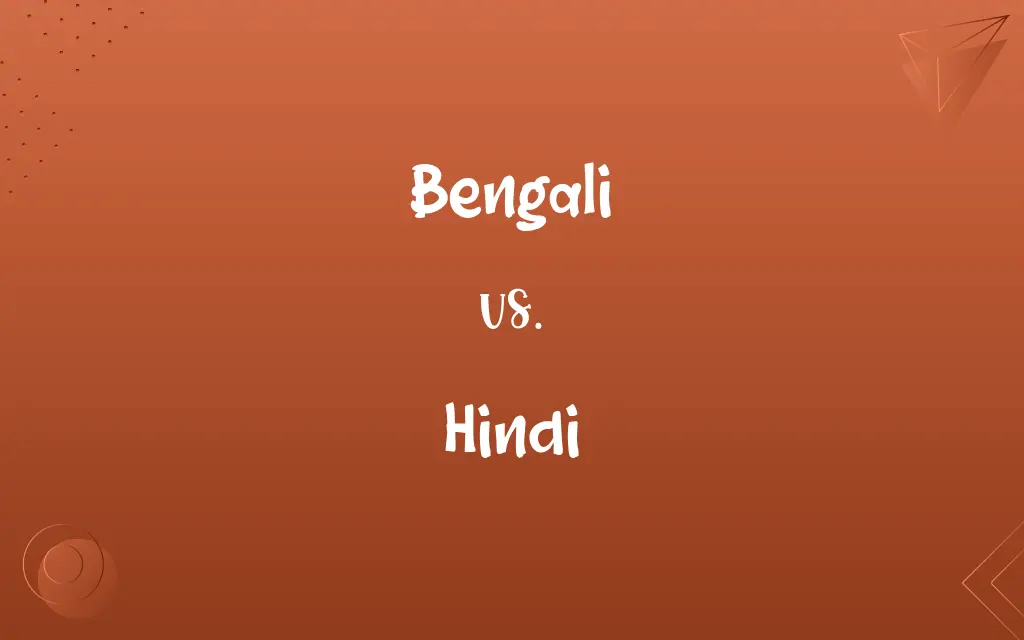Bengali vs. Hindi: Know the Difference

By Shumaila Saeed || Updated on February 23, 2024
Bengali and Hindi are two major Indo-Aryan languages spoken predominantly in South Asia. Bengali is the primary language of Bangladesh and is also spoken in parts of India, while Hindi is mainly spoken in India and serves as one of its official languages.

Key Differences
Bengali and Hindi both stem from the Indo-Aryan language family but have diverged significantly over centuries. Bengali has evolved with strong literary traditions rooted in ancient Sanskrit and Prakrit, with significant Persian and Arabic influences due to Islamic rule. Hindi, while also tracing back to Sanskrit, has absorbed a plethora of words from Persian, Arabic, and Turkic languages through historical conquests, and more recently, English during British colonial rule. These linguistic influences shape vocabulary, syntax, and phonology, making each language unique in its right.
Shumaila Saeed
Feb 23, 2024
The Bengali script is an abugida, where each character represents a consonant with an inherent vowel sound that can be changed with diacritics. This script is distinct and visually different from Hindi's Devanagari script, which also follows an abugida system but with its own set of characters and orthographic rules. This fundamental difference in script not only marks a clear distinction between the two languages but also influences literacy and educational approaches in regions where they are spoken.
Shumaila Saeed
Feb 23, 2024
Both languages boast rich literary canons and have contributed significantly to South Asian literature. Bengali literature is renowned worldwide, particularly for the works of Rabindranath Tagore, while Hindi literature has made profound contributions through various eras, from classical poetry to contemporary writings. These literary traditions reflect the socio-political, historical, and cultural ethos of their respective regions, offering insights into the collective psyche and values of their speakers.
Shumaila Saeed
Feb 23, 2024
Bengali serves as the lingua franca of Bangladesh and is crucial in regional identity, whereas Hindi holds a similar status in India, acting not only as an official language but also as a bridge across the country's diverse linguistic communities. The geographic spread of these languages underscores their importance, with Bengali dominating the eastern subcontinent and Hindi widespread in the north and central regions. This distribution also influences media, education, and government, further entrenching the significance of each language in its respective areas.
Shumaila Saeed
Feb 23, 2024
Bengali and Hindi have vibrant diasporas, spreading their cultural and linguistic influence far beyond South Asia. Through immigration, these language communities have established significant presences in North America, the UK, the Middle East, and beyond. This global footprint has led to increased international interest in learning these languages, their inclusion in global media, and a broader recognition of their cultural contributions, from Bollywood cinema to diaspora literature.
Shumaila Saeed
Feb 23, 2024
ADVERTISEMENT
Comparison Chart
Geographic Distribution
Bangladesh, India (West Bengal, Tripura, Assam)
India, Fiji, Nepal, and among diaspora worldwide
Shumaila Saeed
Feb 23, 2024
Number of Speakers
Approximately 230 million (7th most spoken)
Approximately 600 million (4th most spoken)
Shumaila Saeed
Feb 23, 2024
Literary Tradition
Rich, with early texts from the 8th century; notable for Rabindranath Tagore
Extensive, influenced by Sanskrit; significant modern contributions
Shumaila Saeed
Feb 23, 2024
Phonetics
12 vowels and 52 consonants
Depends on dialect but generally includes 11 vowels and 33 consonants
Shumaila Saeed
Feb 23, 2024
ADVERTISEMENT
Cultural Significance
Strong literary and cultural identity; Pohela Boishakh (New Year)
Widespread influence through Bollywood; Diwali, Holi
Shumaila Saeed
Feb 23, 2024
Influences
Sanskrit, Persian, Arabic, English, and indigenous languages
Sanskrit, Persian, Arabic, English, and Prak
Shumaila Saeed
Feb 23, 2024
Bengali and Hindi Definitions
Hindi
Spread by Bollywood.
Bollywood movies have popularized Hindi worldwide, making it one of the most recognized Indian languages.
Shumaila Saeed
Feb 23, 2024
ADVERTISEMENT
Bengali
Renowned for its literary tradition.
Rabindranath Tagore, a Bengali poet, was the first non-European to win the Nobel Prize in Literature.
Shumaila Saeed
Feb 23, 2024
Hindi
Utilizes Devanagari script.
Hindi is written in the Devanagari script, which is also used for Sanskrit, Marathi, and Nepali.
Shumaila Saeed
Feb 23, 2024
Hindi
The literary and official language of northern India that is based on these dialects. It is written in Devanagari and uses Sanskrit as a resource language.
Shumaila Saeed
Oct 19, 2023
Bengali
Of, pertaining to, or characteristic of Bangladesh (formerly Bengal) or its inhabitants; as, Bengali hills.
Shumaila Saeed
Oct 19, 2023
Hindi
Official language of India.
Hindi is used in government, education, and media, serving as a lingua franca across the country.
Shumaila Saeed
Feb 23, 2024
Bengali
A major Indo-Aryan language.
Bengali is spoken by over 230 million people in Bangladesh and India.
Shumaila Saeed
Feb 23, 2024
Bengali
An ethnic group speaking Bengali and living in Bangladesh and eastern India
Shumaila Saeed
Oct 19, 2023
Hindi
Influenced by multiple languages.
Hindi vocabulary is enriched by Sanskrit, Persian, Arabic, and English words.
Shumaila Saeed
Feb 23, 2024
Bengali
Of or relating to or characteristic of Bengal or its people;
Bengali hills
Shumaila Saeed
Oct 19, 2023
Hindi
The name given by Europeans to that form of the Hindustani language which is chiefly spoken by native Hindus. In employs the Devanagari character, in which Sanskrit is written.
Shumaila Saeed
Oct 19, 2023
Bengali
Written in the Bengali script.
The Bengali script is known for its distinctive horizontal line running along the top of the letters.
Shumaila Saeed
Feb 23, 2024
Bengali
Rich in phonetics.
Bengali language has a comprehensive set of 12 vowels and 52 consonants, accommodating diverse sounds.
Shumaila Saeed
Feb 23, 2024
Hindi
Central to cultural festivals.
Hindi speakers celebrate Diwali and Holi, festivals that have gained international recognition.
Shumaila Saeed
Feb 23, 2024
Hindi
The most widely spoken of modern Indic vernaculars; spoken mostly in the north of India; along with English it is the official language of India; usually written in Devanagari script
Shumaila Saeed
Oct 19, 2023
Bengali
Celebrates Pohela Boishakh.
Pohela Boishakh marks the Bengali New Year, celebrated with colorful processions and cultural events.
Shumaila Saeed
Feb 23, 2024
Bengali
The modern Indic language of Bangladesh and West Bengal, a state of eastern India.
Shumaila Saeed
Oct 19, 2023
Bengali
A Magadhan language spoken by the Bengali people; the official language of Bangladesh and Bengal
Shumaila Saeed
Oct 19, 2023
Bengali
(Hinduism) a member of a people living in Bangladesh and West Bengal (mainly Hindus)
Shumaila Saeed
Oct 19, 2023
Repeatedly Asked Queries
What script is used to write Bengali?
Bengali is written in the Bengali script, an abugida that includes 12 vowels and 52 consonants.
Shumaila Saeed
Feb 23, 2024
How many people speak Hindi worldwide?
Approximately 600 million people speak Hindi globally, making it one of the most spoken languages in the world.
Shumaila Saeed
Feb 23, 2024
What is the origin of the Bengali language?
Bengali evolved from Sanskrit and Magadhi Prakrit, with influences from Persian and Arabic, developing its rich literary and cultural tradition in the region of Bengal.
Shumaila Saeed
Feb 23, 2024
Can speakers of Bengali and Hindi understand each other?
While there are some similarities due to their common Indo-Aryan roots, Bengali and Hindi are distinct languages, and speakers might not understand each other without prior exposure or study.
Shumaila Saeed
Feb 23, 2024
Is Hindi limited to India in terms of its speakers?
Hindi is not limited to India; it is also spoken in countries like Nepal, Fiji, and by the Indian diaspora worldwide.
Shumaila Saeed
Feb 23, 2024
How does the celebration of festivals differ between Bengali and Hindi-speaking regions?
While both cultures celebrate a variety of festivals, specific celebrations like Pohela Boishakh in Bengali culture and Diwali and Holi in Hindi-speaking regions reflect their unique cultural identities.
Shumaila Saeed
Feb 23, 2024
What are some key differences between Bengali and Hindi phonetics?
Bengali has a more extensive set of phonetics with 12 vowels and 52 consonants, compared to Hindi, which typically includes 11 vowels and 33 consonants, reflecting differences in sound and pronunciation.
Shumaila Saeed
Feb 23, 2024
What makes Bengali literature significant?
Bengali literature is significant for its depth, historical richness, and the contributions of Nobel Laureate Rabindranath Tagore, who brought global recognition to Bengali culture.
Shumaila Saeed
Feb 23, 2024
How has Bollywood influenced the Hindi language?
Bollywood has played a crucial role in popularizing Hindi globally, through its films, songs, and dialogues, making it a cultural ambassador of the Hindi language.
Shumaila Saeed
Feb 23, 2024
What influence does Sanskrit have on Bengali and Hindi?
Sanskrit has a profound influence on both Bengali and Hindi, contributing significantly to their vocabularies and literary traditions, as both languages evolved from the Indo-Aryan linguistic family.
Shumaila Saeed
Feb 23, 2024
What role do Bengali and Hindi play in education and government in their respective regions?
In Bangladesh and West Bengal, Bengali is a primary language of education and government, while Hindi holds a similar status in India, being one of the official languages alongside English.
Shumaila Saeed
Feb 23, 2024
How are new words added to the Bengali and Hindi languages?
New words are added through processes such as borrowing from other languages, creating neologisms, and technological advancements, reflecting changes in culture and society.
Shumaila Saeed
Feb 23, 2024
Are Bengali and Hindi mutually intelligible?
Generally, Bengali and Hindi are not mutually intelligible due to their different scripts, phonetics, and vocabulary, although there might be some overlap in basic words and phrases.
Shumaila Saeed
Feb 23, 2024
What challenges do Bengali and Hindi face in the digital age?
Challenges include digital representation and standardization, ensuring adequate resources for language learning, and preserving the linguistic diversity against the dominance of English online.
Shumaila Saeed
Feb 23, 2024
How do Bengali and Hindi contribute to the cultural diversity of South Asia?
Bengali and Hindi contribute to South Asia's cultural diversity through their literature, cinema, music, festivals, and daily communication, reflecting the rich heritage and dynamic cultural landscape of the region.
Shumaila Saeed
Feb 23, 2024
Share this page
Link for your blog / website
HTML
Link to share via messenger
About Author
Written by
Shumaila SaeedShumaila Saeed, an expert content creator with 6 years of experience, specializes in distilling complex topics into easily digestible comparisons, shining a light on the nuances that both inform and educate readers with clarity and accuracy.








































































